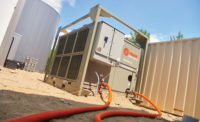Today, consumers can walk into any big-box store, purchase any kind of mechanical or electronic device, and, in most instances, the checkout clerk will attempt to sell them an extended warranty. Most people like the idea of an insurance policy, especially when it comes to big-ticket items like HVAC systems. While there are pros and cons to offering extended warranties, most contractors agree offering this added assurance differentiates themselves from their competition and makes them that much more valuable to customers.
WARRANTY BENEFITS
Extended warranties allow HVAC contractors to expand their customer bases, according to Evan Myers, vice president of marketing, JB & Associates Extended Warranties.
“When a contractor uses our program to purchase a plan and then resells it to a homeowner, the contractor is locked into that agreement,” Myers said. “Not every program does that. A lot of extended service contract programs will sell an agreement to the end user and then dispatch any contractor in their service network when a failure occurs.”
Additionally, by expanding their customer base, contractors see additional profits.
“When contractors sell ESAs [extended service agreements] to homeowners, there is a little bit of room for some markup,” Myers added. “So, they’re going to make some points on the front end of the sale, and they’re locking that customer in for future potential revenue, as well. For contractors, it’s a great way to retain customers and generate revenue.”
JB & Associates offers a variety of extended warranty plans, including 10-year-labor, five-year-labor, and 10-year-labor/refrigerant options. “Different options allow contractors to be flexible in how they price and market their warranty offerings,” Myers said.
In addition to adding customers and increasing profits, one of the largest overall benefits to offering extended warranties is brand protection and protecting the consumer relationship, according to Billy Leonard, vice president of sales, HVAC division, AIG Warranty.
“Warranties protect the consumer experience and contractor-consumer relationship,” he said. “Now, more than ever, consumers have an expectation that when they spend $8,000 for an installation, they’re not going to have any issues they have to pay for out of pocket. It’s definitely going to make them upset if something happens. To avoid that, we get as many dealers as possible to incorporate a warranty into the price of the job.
“It’s imperative that contractors protect their brands,” Leonard continued. “One of the things we see in the age of social media is that if you have a dissatisfied homeowner, now more than ever, they can share their concerns on the internet. One negative experience can create somewhat of a snowball effect.”
John Grimaldi, vice president of business development, Trinity Warranty, agreed, saying the most important benefit is having a satisfied customer.
“A few years ago, we did a focus group with 10 contractors, and the biggest complaint with warranties was the consumer does not hear that it’s just parts only,” Grimaldi said. “They would go to a customer’s home, change out the compressor, and then bill the customer $500. The customer would get mad, threaten to call the Better Business Bureau, and, next thing you know, the contractor is writing an invoice for $200. If the customer had an extended service agreement [ESA] on the system, there would have been no arguments. That customer would have been happily telling friends and family the contractor replaced the compressor and it didn’t cost him a dime. ESAs help extend that positive relationship.”
HOW TO SELL
When it comes to selling ESAs, JB & Associates advises contractors to stay away from the add-on sales approach.
“Anytime an individual purchases something and the seller asks, ‘By the way, do you want to buy an extended warranty,’ most homeowners are going to decline,” Myers said. “I always encourage contractors to enhance their product by showing the ESA as an added benefit up front and not as an added cost at the end of a sale. It makes a huge difference.”
Myers advises using inclusive selling by rolling the ESA into all estimates or via an option-selling program.
“Give your customer a silver, gold, or platinum plan option. Consumers love to have options. Most of the time, they’re going to pick the best one, or, at least, the middle option.”
Additionally, contractors can also use incentive selling, where they offer some sort of special item or discount with the purchase of an ESA, Myers noted.
Leonard said one of the biggest problems is consumers don’t realize how much labor actually costs. “Generally speaking, the part only makes up about 30 percent of the average service ticket. That leaves about 70 percent of the service ticket tied to the diagnostic, and consumers are shocked that the 10-year warranty covers so little of the expense.”
To combat price objectives, AIG has been marketing shorter-term warranties.
“Dealers are used to selling 10-year labor warranties. They think they have to match it with the 10-year parts warranty or bust,” Leonard said. “We’re trying to change that mindset. Instead of trying to always sell $1,000 10-year warranties, take a step back and simply meet a customer’s demand. Three-year warranties cost $100-$200, at most, and, from the customer’s perspective, $200 on top of an $8,000 system is a much more palatable price point. Consumer polling across other industries indicates warranty sales are increasing. There is a demand, but pricing is the big issue. Contractors are coming to the market with the wrong tools, so to speak. So, we’re trying to reset the mind of dealers and are anticipating the three-year warranty approach will work very well.”
Grimaldi noted that ESAs can be rolled into financing, and customers can get coverage for just a few dollars per month.
“People look at monthly payments today; they don’t look at the total payment,” he said. “They look at how much this is going to cost per month. If they add on a $600 ESA to a $6,000 system, it would increase the payment a few dollars per month. The best contractors out there just put it right on the invoice. They sell the system and say, ‘With this purchase, you’re entitled to a 10-year parts-and-labor warranty.’”
Trinity Warranty recently partnered with a major retailer to go after customers who put in HVAC systems but did not purchase extended warranties.
“They gave us a customer list, so we knew exactly what they installed,” Grimaldi said. “The subcontractors’ close rate for ESAs was less than 7 percent. Our close rate was 75 percent, and we accomplished this just by cold-calling customers. If we can do it by telemarketing, the contractor should be able to do it as they are already in the customers’ homes.”
Additionally, Grimaldi suggested getting employees on board with selling ESAs by offering spiffs on each agreement sold.
CONTRACTORS WEIGH IN
As a Trane dealer, Scott Merritt, owner of Fire & Ice Heating & Air Conditioning in Columbus, Ohio, offers his customers five- and 10-year extended labor warranties through AIG in addition to the 10-year parts warranty supplied by the manufacturer.
“It’s really about options,” he said. “It’s important for us as a full-time HVAC retailer to offer customers all available options all the time. People buy them for different reasons. Some want extended warranties, some don’t. It’s our job to make sure they know it’s available, if they do want it.”
Merritt said about 10-20 percent of customers purchase extended warranties, and it often depends on the salesperson doing the selling.
“We have a pretty good training program here, and we try to deliver the same message every time, but there’s always a level of personality involved,” he explained. “Some salespeople believe in extended warranties a little bit more than others, so they’ll sell more because they’ll present it to the customer in a better, more optimistic way than others. People coming from outside the industry sell plenty of them — about 30 percent of jobs. But the guys who have been in the field for 20 years, they’re not so interested in selling them. It’s something new that they’ve never had to do before.”
Merritt also said more customers want extended warranties than ever before. “There is definitely more of a desire for extended warranties with today’s high-tech equipment. Even the best equipment breaks down sometimes — even if it was put in perfectly and setup just right. If you don’t have an extended warranty, it can get pretty expensive to repair — even if it’s just labor-only, because the higher-tech equipment sometimes takes a little while to figure out what’s going on with it.”
However, as great as extended warranties are for customers, they’re not the greatest source of revenue for contractors, Merritt noted.
“If I have a customer with a 10-year warranty and, after five years, the unit breaks down, we will go out, work on it, and get money back from AIG. Now, AIG is not going to pay me what I usually charge COD [cash on delivery] customers for a service call,” Merritt said. “So, overall, it’s not necessarily good for the company to have a bunch of warranties. Additionally, even if I sell the extended warranty for Trane, technically, any Trane dealer can service that equipment. They can go out tomorrow, get another Trane dealer, and transfer the warranty over to them for a $49 fee. So, these agreements don’t necessarily lock customers in with us. As far as the company goes, it’s good to have the option for the customer, but it’s bad for the company. I try to mix it in. We don’t push them that hard, but we do make sure everybody understands we have it because we want them to have options they can choose. But, we don’t want too many because there is really no money in it.”
Tim Paetz, general manager and co-owner of Bud Anderson Heating and Cooling in Lowell, Arkansas, said he offers ESAs with everything he sells.
“Everything we do has a 12-year parts-and-labor warranty attached to it unless the customer doesn’t want it,” he said. “Then we’ll cut it down to 12-year parts, which comes on the equipment, and one year for labor.”
As a Daikin dealer, Bud Anderson is guaranteed service work by selling ESAs, Paetz noted. “We’ll have that revenue stream coming in from warranty work, and we’ll get them on maintenance contracts, too. Customers have maintenance performed twice a year, as well, which helps keep the client with us. It’s guaranteed revenue and keeps us busy during the offseason.”
Paetz said Bud Anderson includes the cost of the ESA right into the job bid, though such plans generally cost around $1,200. If customers object to the price, the company will try to explain the advantages of having an ESA and will downsell from there.
“People want warranties today,” he said. “They are going to be in their homes a long time. And, when something breaks, for the next 12 years, they can have us come fix it at no cost to them. When was the last time you had something like that? And really, if you have just one repair in 12 years, then that investment has essentially just paid itself off. If you have a compressor that goes bad, you’re looking at $1,200-$1,400 just to replace it if you don’t have an extended warranty.”
Bud Anderson will also run specials during the year, including offering 16-year extended warranties to customers. “We take the additional four years in-house,” Paetz said.
Unlike Merritt, Paetz explained he doesn’t really see any loss in revenue, as his company is repaid its labor rate when it puts in parts through a warranty service, which helps with the overhead. “Granted, we’re not making money on the part,” he added.
Gaithersburg, Maryland-based GAC Services offers its own 10-year labor warranty in-house, according to Rich Biava, company vice president.
“We do it to try and differentiate ourselves in the marketplace when people buy higher-end systems from us,” he said. “We believe we have the best installation process in town, and we want our customers to know when they’re buying from us, we’re not going to do the install and disappear. We want to have a long-term relationship with them. This is a way to differentiate ourselves and a way for us to provide value to our product.
“I’d rather not talk to customers four or five years after their systems were installed to discuss problems,” Biava continued. “And, I don’t want my employees to have to deal with that either. If they did buy from us and it died in a few years, let’s minimize the pain for the customer by standing behind our product and what we do.”
Additionally, by offering the ESA with the purchase of a high-end system, GAC has a great way to incentivize its customers to purchase maintenance agreements.
“We don’t enforce ESAs, but we do encourage them,” Biava explained. “These people care about their homes, so, for another couple hundred dollars, it isn’t an overwhelming price for them to lock in maintenance. Just like a vehicle or anything else that’s motorized, the HVAC system needs maintenance or problems will likely occur. In our extended warranties, there is fine print that states routine maintenance is required to keep a 10-year warranty valid.”
Biava agreed there probably is a loss of revenue to the business to some degree. “If you look at that loss of revenue as the cost to retain customers and the cost to have a good name in the marketplace, I guess one could say that’s so, but, to us, that’s the cost of doing business. What is the cost for having a happy customer refer you to friends and family? I like the way we do it. Could we be making more money if we did it differently? Possibly. But, at the end of the day, we have a great group of customers, our techs feel comfortable with the program we provide, and we’re winning customers. So, we’re doing something right.”
Publication date: 7/11/2016
Want more HVAC industry news and information? Join The NEWS on Facebook, Twitter, and LinkedIn today!






Report Abusive Comment